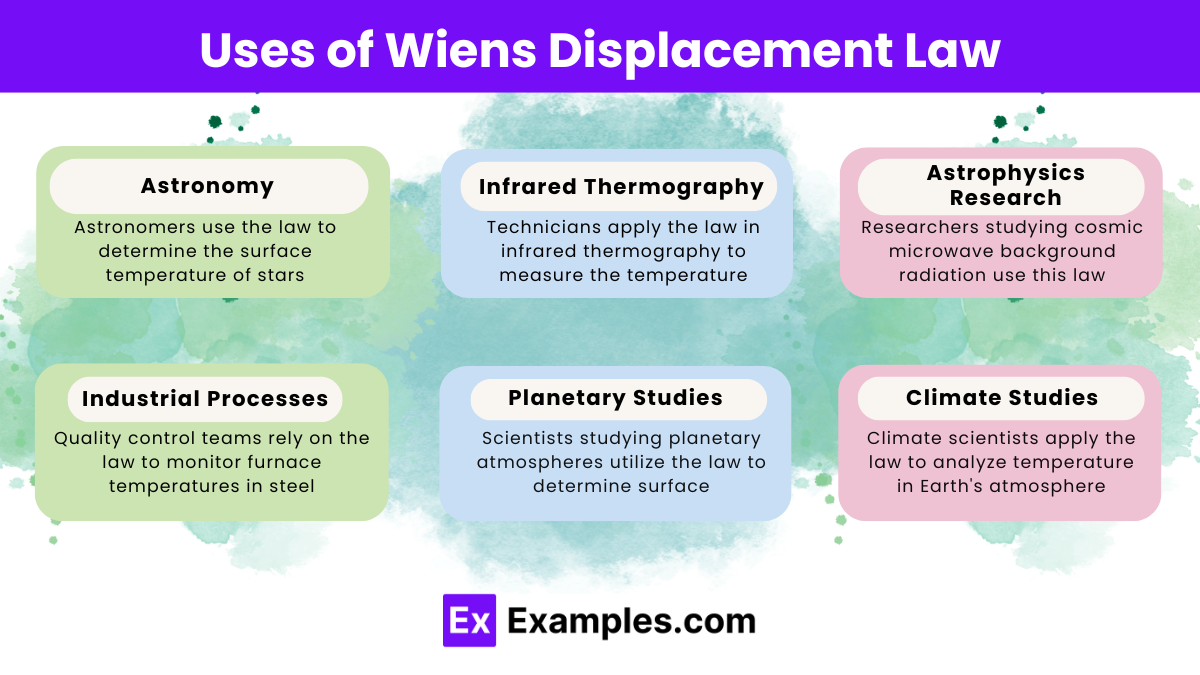What does Wien's Displacement Law state about the relationship between the temperature of a black body and the wavelength at which it emits maximum radiation?
Directly proportional
Inversely proportional
No relationship
Exponentially proportional


Wien’s Displacement Law describes the relationship between the temperature of a blackbody (an idealized object that absorbs all incident radiation) and the wavelength at which it emits radiation most strongly. In essence, as the temperature of the blackbody increases, the peak wavelength at which it emits light decreases, meaning that the color of the emitted light shifts to shorter wavelengths.
The formula for Wien’s Displacement Law is:
where:
This formula indicates that the peak wavelength decreases as the temperature increases, meaning that hotter objects emit light at shorter wavelengths.
Wien’s Displacement Constant (often denoted as 𝑏) is a physical constant used in Wien’s Displacement Law to describe the relationship between the temperature of a blackbody and the wavelength at which it emits radiation most strongly. Its approximate value is:
This constant is used in the formula: 𝜆ₘₐₓ=𝑏𝑇
Wien’s Displacement Law is primarily expressed as:
𝜆ₘₐₓ=𝑏𝑇
There are alternative ways to express this relationship:
In Terms of Frequency: Since frequency (𝑓) and wavelength (𝜆) are related through the speed of light (c), we can derive a formula involving the peak frequency (𝑓ₘₐₓ):
𝑓ₘₐₓ = 𝑐/𝜆ₘₐₓ = 𝑐𝑇/𝑏
In Energy Terms: Using Planck’s equation that relates the energy (𝐸) of a photon to its frequency:
𝐸ₘₐₓ=ℎ⋅𝑓ₘₐₓ=ℎ𝑐𝑇/𝑏
These alternate expressions allow the relationship to be examined in different ways, such as in terms of energy or frequency rather than wavelength.

Wien’s Displacement Law plays a crucial role in several scientific and practical applications:
Wien’s Law is accurate for determining the peak wavelength of blackbody radiation at high temperatures. However, it is less accurate at lower temperatures, where Planck’s Law is more precise.
Wien’s Law fails at lower temperatures because it doesn’t account for longer-wavelength radiation. Planck’s Law, which includes all wavelengths, better models the full spectrum in these cases.
Astronomers use Wien’s Law to estimate the temperature of stars by analyzing the peak wavelength of their emitted light, revealing stellar temperatures from color shifts.
Text prompt
Add Tone
10 Examples of Public speaking
20 Examples of Gas lighting
What does Wien's Displacement Law state about the relationship between the temperature of a black body and the wavelength at which it emits maximum radiation?
Directly proportional
Inversely proportional
No relationship
Exponentially proportional
Which formula represents Wien\'s Displacement Law?
λₘₐₓ = c/T
λₘₐₓ = kT
λₘₐₓ = b/T
λₘₐₓ = T/c
If the temperature of a black body increases, what happens to the wavelength of maximum emission?
Increases
Decreases
Remains constant
Becomes zero
What type of relationship exists between temperature and wavelength in Wien's Displacement Law?
Linear
Inverse
Quadratic
No relationship
Wien's Displacement Law is applicable to which type of radiation?
Visible light
Black body radiation
Ultraviolet light
Infrared light
For a black body at 3000 K, what is the approximate wavelength of maximum emission?
966 nm
966 µm
966 cm
966 mm
How does Wien\'s Displacement Law help in determining the temperature of stars?
By measuring their size
By measuring their distance
By measuring their peak emission wavelength
By measuring their age
What is the significance of the constant 'b' in Wien's Displacement Law?
It determines the intensity of radiation
It relates temperature to peak emission wavelength
It measures the total energy emitted
It quantifies the speed of light
Which of the following best describes the temperature dependence of the peak wavelength according to Wien\'s Displacement Law?
λₘₐₓ is directly proportional to T
λₘₐₓ is inversely proportional to T
λₘₐₓ is independent of T
λₘₐₓ is proportional to T²
Wien's Displacement Law can be used to estimate the temperature of which astronomical objects?
Planets
Stars
Comets
Asteroids
Before you leave, take our quick quiz to enhance your learning!

